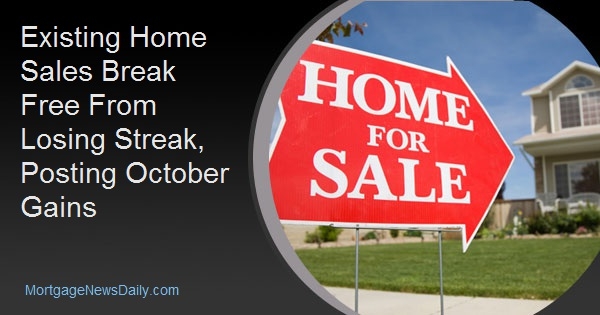Existing home sales broke their extended losing streak in October, increasing 1.4 percent from September to a seasonally adjusted annual rate of 5.22 million completed sales. It was the first positive report on sales of existing single-family homes, condos, townhouses, and co-op apartments since last March. The National Association of Realtors® (NAR) said the gain was not enough however to return existing home sales activity to 2017 levels. They lag the 5.5 million transactions last October by 5.1 percent
After overshooting the mark with their last six forecasts, analysts polled by Econoday were more restrained and consequently quite accurate in their expectations for October. Their predictions were in the range of 5.10 to 5.35 million units with a consensus of 5.20 million.
Single-family home sales were at a seasonally adjusted annual rate of 4.62 million in October compared to 4.58 million in September and are 5.3 percent below the 4.88 million rate a year earlier. Existing condo and co-op sales rose 5.3 percent to an adjusted annual rate of 600,000 units but they remain down 3.2 percent on a year-over-year basis.
Lawrence Yun, NAR's chief economist, says increasing housing inventory has brought more buyers to the market. "After six consecutive months of decline, buyers are finally stepping back into the housing market," he said. "Gains in the Northeast, South and West - a reversal from last month's steep decline or plateau in all regions - helped overall sales activity rise for the first time since March 2018."
The median existing-home price for all housing types in October was $255,400, up 3.8 percent from last October's median of $246,000. October's price increase marks the 80th straight month of year-over-year gains. The median single-family price was $257,900 representing 4.3 percent annual appreciation. Condo prices eased by 0.2 percent to a median of $236,200.
Overall housing inventory declined from 1.88 million available homes in September to 1.85 million, but that is a half-million more listings than in October 2017. Unsold inventory is at a 4.3-month supply at the current sales pace, down from 4.4 last month and up from 3.9 months a year ago.
Properties typically stayed on the market for 33 days in October, up from 32 days in September but down from 34 days a year ago. Forty-six percent of homes sold in October were on the market for less than a month.
"As more inventory enters the market and we head into the winter season, home price growth has begun to slow more meaningfully," said Yun. "This allows for much more manageable, less frenzied buying conditions."
"Rising interest rates and increasing home prices continue to suppress the rate of first-time homebuyers. Home sales could further decline before stabilizing. The Federal Reserve should, therefore, re-evaluate its monetary policy of tightening credit, especially in light of softening inflationary pressures, to help ease the financial burden on potential first-time buyers and assure a slump in the market causes no lasting damage to the economy," says Yun.
First-time buyers were responsible for 31 percent of sales in October, down 32 percent both in September and the previous October. Individual investors purchased 15 percent of homes, up by 2 points from both earlier periods. Cash sales made up 23 percent of all transactions, also slightly higher than in September and October 2017.
Distressed sales, foreclosures and short sales, accounted for 3 percent of sales, unchanged from last month and 1 percentage point lower than a year earlier. This is the lowest level for these sales since NAR began tracking them in October 2008.
Sales were up in three of the four regions. In the Northeast existing home sales gained 1.5 percent to an annual rate of 690,000, 6.8 percent below a year ago. The median price in the Northeast was $280,900, which is 3.0 percent higher than last October.
In the Midwest, existing-home sales declined 0.8 percent from last month and 3.1 percent on an annual basis to 1.27 million in October. The median price in the Midwest was $197,000, a 2.4 percent annual gain.
Existing-home sales in the South rose 1.9 percent to an annual of 2.15 million units, a 2.3 percent annual decline. The region's median price increased 3.8 percent to $221,60.
Sales in the West grew 2.8 percent to an annual rate of 1.11 million but were down 11.2 percent from the previous October. Prices increased a median of 1.9 percent to $382,900.







